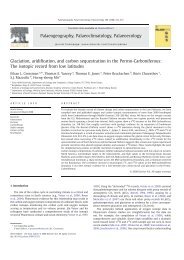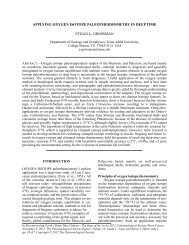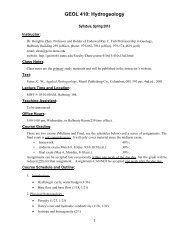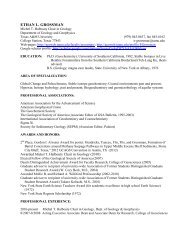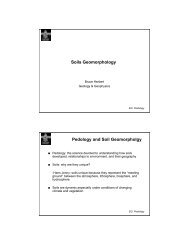An analytical solution for non-Darcian flow in a confined
An analytical solution for non-Darcian flow in a confined
An analytical solution for non-Darcian flow in a confined
You also want an ePaper? Increase the reach of your titles
YUMPU automatically turns print PDFs into web optimized ePapers that Google loves.
ADWR 1178 No. of Pages 12, Model 5+<br />
17 July 2007 Disk Used<br />
ARTICLE IN PRESS<br />
6 Z. Wen et al. / Advances <strong>in</strong> Water Resources xxx (2007) xxx–xxx<br />
397 curves are not always obvious because of the <strong>non</strong>-l<strong>in</strong>ear<br />
398 power law relationship between the discharge and the<br />
399 hydraulic gradient. Furthermore, it is straight<strong>for</strong>ward to<br />
400 test the sensitivity of the <strong>solution</strong>s to two parameters n<br />
401 and k <strong>in</strong> dimensional <strong>for</strong>ms. There<strong>for</strong>e, we prefer a dimen-<br />
402 sional analysis <strong>for</strong> most parts of the follow<strong>in</strong>g analysis. The<br />
403 type curves are only used when the results are compared<br />
404 with previous <strong>solution</strong>s of <strong>Darcian</strong> <strong>flow</strong> under the special<br />
405 case of n =1.<br />
406 Nevertheless, the type curves <strong>for</strong> <strong>non</strong>-<strong>Darcian</strong> <strong>flow</strong><br />
407 can be easily obta<strong>in</strong>ed based on the dimensional analysis<br />
408 if the dimensionless terms can be adequately def<strong>in</strong>ed.<br />
409 With the developed MATLAB program <strong>for</strong> the numeri-<br />
410 cal Laplace <strong>in</strong>version, we have obta<strong>in</strong>ed the drawdown<br />
411 values aga<strong>in</strong>st time which are presented <strong>in</strong> log–log scales,<br />
412 as shown <strong>in</strong> Figs. 2–13. In the follow<strong>in</strong>g discussion, we<br />
413 only consider the case that n is larger than one, because<br />
414 pre-l<strong>in</strong>ear <strong>flow</strong> is unlikely to occur near the pump<strong>in</strong>g<br />
415 wells.<br />
416 3.1. Drawdowns without wellbore storage<br />
417 3.1.1. Comparison of the <strong>non</strong>-l<strong>in</strong>ear type curves with Theis<br />
418 curves<br />
419 When n approaches one, <strong>flow</strong> is approach<strong>in</strong>g <strong>Darcian</strong>.<br />
420 The result of Eq. (18) will approach the classical Theis solu-<br />
421 tion <strong>in</strong> the Laplace doma<strong>in</strong>. We have compared our results<br />
422 <strong>for</strong> n = 1 with the Theis type curves as shown <strong>in</strong> Fig. 2,<br />
423 which has the same axes as those def<strong>in</strong>ed <strong>in</strong> Theis type<br />
424 curves, i.e. u ¼ r2 S<br />
and W ðuÞ ¼ 4pmk sðr; tÞ. It is clear to<br />
4mkt<br />
Q<br />
425 see that our results agree perfectly with the Theis type<br />
426 curves. This <strong>in</strong>dicates that our MATLAB program based<br />
Fig. 3. Comparison of the drawdowns obta<strong>in</strong>ed by the proposed<br />
l<strong>in</strong>earization and Laplace trans<strong>for</strong>m method and the Boltzmann trans<strong>for</strong>m<br />
method with n = 2.0, Q =50m 3 /h, m =50m, k = 0.1(m/h) n , and<br />
S = 0.001 <strong>for</strong> the distances r = 10 m and 100 m, respectively.<br />
Fig. 4. Drawdowns versus r 2 /t with n = 1.5, Q =50m 3 /h, m =50m,<br />
k = 0.1(m/h) n , and S = 0.001 <strong>for</strong> the distances r =10m,20m,50m,and<br />
100 m, respectively.<br />
UNCORRECTED PROOF<br />
Fig. 2. Comparison of the type curves <strong>for</strong> <strong>non</strong>-<strong>Darcian</strong> <strong>flow</strong> and Theis<br />
type curves.<br />
on the numerical <strong>in</strong>version is applicable. On the other<br />
hand, it may suggest that the errors of the l<strong>in</strong>earization<br />
approximation are negligible at least when n is close to<br />
one. In the follow<strong>in</strong>g analysis, we consider the l<strong>in</strong>earization<br />
<strong>solution</strong>s as ‘‘quasi-exact’’ <strong>solution</strong>s when compar<strong>in</strong>g to the<br />
results of the Boltzmann method.<br />
427<br />
428<br />
429<br />
430<br />
431<br />
432<br />
Please cite this article <strong>in</strong> press as: Wen Z et al., <strong>An</strong> <strong>analytical</strong> <strong>solution</strong> <strong>for</strong> <strong>non</strong>-<strong>Darcian</strong> <strong>flow</strong> <strong>in</strong> a conf<strong>in</strong>ed ..., Adv Water Resour<br />
(2007), doi:10.1016/j.advwatres.2007.06.002



